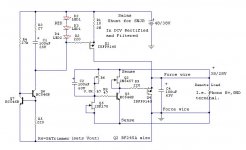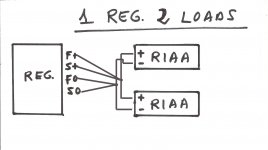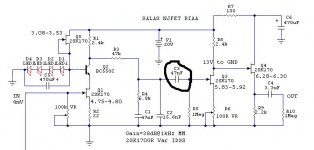Regarding the two electrolitycs i've seen some shunt versions where you recomended 1000uf but in mine also 100uf. Is 100uf enough ? Would be 470uf let's say, bad ?
They aren't exactly the same. 220uF for the one across the trimmer maybe, don't change the output one's value though.
With 1n resolution you can' t possibly know what values you have on the riaa capacitors. The first thing I would do is find a way to measure riaa caps with a better accuracy and then change other things.
That calls for a cap meter, doesn't it? Could someone advise a reasonably priced one?
I use this one TONGHUI DIGITAL HANDHELD LCR/LCZ/LCRZ METER,TH2821B,1K | eBay and I am really happy with it.
I haven' t yet find something as accurate much cheaper. Maybe others can recommend something else.
I haven' t yet find something as accurate much cheaper. Maybe others can recommend something else.
I use this one TONGHUI DIGITAL HANDHELD LCR/LCZ/LCRZ METER,TH2821B,1K | eBay and I am really happy with it.
I haven' t yet find something as accurate much cheaper. Maybe others can recommend something else.
Lovely aparatus. Although to justify that sort of expensive I have to think if it will be usable in the future. Recaping 20 years old Spendor XOs? Maybe...
As for this project, an alternative would be ordering matched caps?
I initially bought it to measure crossover inductors. Later found it usable on my njfet riaa.
Matched caps is not enough, you need exact values too.
Matched caps is not enough, you need exact values too.
Sorry... I meant 72-8150 also from farnell http://pt.farnell.com/tenma/72-8150/multimeter-cr/dp/1283644
Capacitance Measuring Range: 200pF, 2nF, 20nF, 200nF, 2µF, 20µF, 200µF, 2mF, 20mF
Capacitance Range Accuracy: ± (0.5% + 10d)
Incredibly good for 32€
Capacitance Measuring Range: 200pF, 2nF, 20nF, 200nF, 2µF, 20µF, 200µF, 2mF, 20mF
Capacitance Range Accuracy: ± (0.5% + 10d)
Incredibly good for 32€
Tenma is UNI-T btw. With 2000 counts display and no Kelvin leads can go 0.5% at 32Euro for real? I wonder what that ± (0.5% + 10d) may do.
In fact it is quite good... I checked it with some 0.3% caps and it provides consistent results.
Should be very good for the price but 0.5% +10 digit in a 2000 counts display really means 1.5% for a 10uF reading.
*That stands probably without using the leads but the little panel slots.
*That stands probably without using the leads but the little panel slots.
My Nagaoka 110 cartridge has arrived and i can say that my Salas preamp sounds really sweet. Also i ordered a aluminium box for it so i need some helping answers meantime enclosure arrives from China:
- how to connect power (sense, force) from shunt regulator to both channels of preamp as my pcb design is a dual mono approach? (positive and grounding are separated for every channel)
- knowing i need 20volt for preamp wich would be the minimum voltage on the entrance of shunt regulator? Is enough to be only rectified and filtered? (now i have a LM317 as stabilizator before shunt)
-is that a bad idea to have the metal enclosure as a general ground, the RCA in and out should be connected or isolated from the box?
Thaks a lot !
- how to connect power (sense, force) from shunt regulator to both channels of preamp as my pcb design is a dual mono approach? (positive and grounding are separated for every channel)
- knowing i need 20volt for preamp wich would be the minimum voltage on the entrance of shunt regulator? Is enough to be only rectified and filtered? (now i have a LM317 as stabilizator before shunt)
-is that a bad idea to have the metal enclosure as a general ground, the RCA in and out should be connected or isolated from the box?
Thaks a lot !
Nagaoka easily betters your Ortofon OM5? Had to change loading values?
- For first question see attached. (+Riaa=V+, -Riaa=GND).
-30Vin is good for regulation and mains variation. Avoid less than 25V. Your 317 before shunt can be good or can have weird interactions. Try listen without it, the reg is designed for C filter or CRC, CLC, passives to be enough.
-You got to have the case at circuit's GND potential to minimize hum pick up anyway but have GND defined paths, so isolate RCAs and use coaxial signal cables to minimize the field sensitive loop area. You may use just one wire from where F0,S0 meet RIAA channels GND link to reference the chassis.
- For first question see attached. (+Riaa=V+, -Riaa=GND).
-30Vin is good for regulation and mains variation. Avoid less than 25V. Your 317 before shunt can be good or can have weird interactions. Try listen without it, the reg is designed for C filter or CRC, CLC, passives to be enough.
-You got to have the case at circuit's GND potential to minimize hum pick up anyway but have GND defined paths, so isolate RCAs and use coaxial signal cables to minimize the field sensitive loop area. You may use just one wire from where F0,S0 meet RIAA channels GND link to reference the chassis.
Attachments
Well Nagaoka 110 and Ortofon Om5E are from different stories. Sometimes i miss the precision of ortofon but i hope Nagaoka will become more precise after break-in. Now Nagaoka is a bit too laid back and lacks treble a bit but sounds very sweet.
The 47nf cap marked in the picture can be 100nf or 220nf? As far i can understand he is not a part of RIAA network.
I'm asking this because i've found some 0,1uf russian PIO caps wich i think will be better than my cheap poliester caps. Or should i push for some teflons ? http://www.ebay.com/itm/K42Y-2-0-1u...ps=63&clkid=6648419942149181386#ht_820wt_1187
For RIAA would be a good choice these http://www.adelaida.ro/product_info.php?products_id=18396&osCsid=1af64bd6b3323004e763251b112fc50f
The 47nf cap marked in the picture can be 100nf or 220nf? As far i can understand he is not a part of RIAA network.
I'm asking this because i've found some 0,1uf russian PIO caps wich i think will be better than my cheap poliester caps. Or should i push for some teflons ? http://www.ebay.com/itm/K42Y-2-0-1u...ps=63&clkid=6648419942149181386#ht_820wt_1187
For RIAA would be a good choice these http://www.adelaida.ro/product_info.php?products_id=18396&osCsid=1af64bd6b3323004e763251b112fc50f
Attachments
Last edited:
- Home
- Source & Line
- Analogue Source
- Simplistic NJFET RIAA


